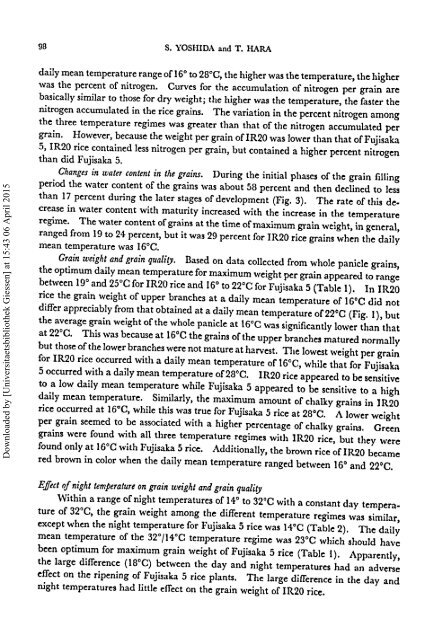Yoshida und Hara - 1977 - Effects of air temperature and light on grain fill
Yoshida und Hara - 1977 - Effects of air temperature and light on grain fill
Yoshida und Hara - 1977 - Effects of air temperature and light on grain fill
Create successful ePaper yourself
Turn your PDF publications into a flip-book with our unique Google optimized e-Paper software.
98 S. YOSHIDA <str<strong>on</strong>g>and</str<strong>on</strong>g> T. HARA<br />
Downloaded by [Universitaetsbibliothek Giessen] at 15:43 06 April 2015<br />
daily mean <str<strong>on</strong>g>temperature</str<strong>on</strong>g> range <str<strong>on</strong>g>of</str<strong>on</strong>g> 16° to 28°C, the higher was the <str<strong>on</strong>g>temperature</str<strong>on</strong>g>, the higher<br />
was the percent <str<strong>on</strong>g>of</str<strong>on</strong>g> nitrogen. Curves for the accumulati<strong>on</strong> <str<strong>on</strong>g>of</str<strong>on</strong>g> nitrogen per <strong>grain</strong> are<br />
basically similar to those for dry weight; the higher was the <str<strong>on</strong>g>temperature</str<strong>on</strong>g>, the faster the<br />
nitrogen accumulated in the rice <strong>grain</strong>s. The variati<strong>on</strong> in the percent nitrogen am<strong>on</strong>g<br />
the three <str<strong>on</strong>g>temperature</str<strong>on</strong>g> regimes was greater than that <str<strong>on</strong>g>of</str<strong>on</strong>g> the nitrogen accumulated per<br />
<strong>grain</strong>. However, because the weight per <strong>grain</strong> <str<strong>on</strong>g>of</str<strong>on</strong>g>IR20 was lower than that <str<strong>on</strong>g>of</str<strong>on</strong>g> Fujisaka<br />
5, IR20 rice c<strong>on</strong>tained less nitrogen per <strong>grain</strong>, but c<strong>on</strong>tained a higher percent nitrogen<br />
than did Fujisaka 5.<br />
Changes in water c<strong>on</strong>tent in the <strong>grain</strong>s. During the initial phases <str<strong>on</strong>g>of</str<strong>on</strong>g> the <strong>grain</strong> <strong>fill</strong>ing<br />
period the water c<strong>on</strong>tent <str<strong>on</strong>g>of</str<strong>on</strong>g> the <strong>grain</strong>s was about 58 percent <str<strong>on</strong>g>and</str<strong>on</strong>g> then declined to less<br />
than 17 percent during the later stages <str<strong>on</strong>g>of</str<strong>on</strong>g> development (Fig. 3). The rate <str<strong>on</strong>g>of</str<strong>on</strong>g> this decrease<br />
in water c<strong>on</strong>tent with maturity increased with the increase in the <str<strong>on</strong>g>temperature</str<strong>on</strong>g><br />
regime. The water c<strong>on</strong>tent <str<strong>on</strong>g>of</str<strong>on</strong>g> <strong>grain</strong>s at the time <str<strong>on</strong>g>of</str<strong>on</strong>g> maximum <strong>grain</strong> weight, in general,<br />
ranged from 19 to 24 percent, but it was 29 percent for IR20 rice <strong>grain</strong>s when the daily<br />
mean <str<strong>on</strong>g>temperature</str<strong>on</strong>g> was 16°C.<br />
Grain weight <str<strong>on</strong>g>and</str<strong>on</strong>g> <strong>grain</strong> quality. Based <strong>on</strong> data collected from whole panicle <strong>grain</strong>s,<br />
the optimum daily mean <str<strong>on</strong>g>temperature</str<strong>on</strong>g> for maximum weight per <strong>grain</strong> appeared to range<br />
between 19° <str<strong>on</strong>g>and</str<strong>on</strong>g> 25°C for IR20 rice <str<strong>on</strong>g>and</str<strong>on</strong>g> 16° to 22°C for Fujisaka 5 (Table 1). In IR20<br />
rice the <strong>grain</strong> weight <str<strong>on</strong>g>of</str<strong>on</strong>g> upper branches at a daily mean <str<strong>on</strong>g>temperature</str<strong>on</strong>g> <str<strong>on</strong>g>of</str<strong>on</strong>g> 16°C did not<br />
differ appreciably from that obtained at a daily mean <str<strong>on</strong>g>temperature</str<strong>on</strong>g> <str<strong>on</strong>g>of</str<strong>on</strong>g> 22°C (Fig. 1), but<br />
the average <strong>grain</strong> weight <str<strong>on</strong>g>of</str<strong>on</strong>g> the whole panicle at 16°C was significantly lower than that<br />
at 22°C. This was because at 16°C the <strong>grain</strong>s <str<strong>on</strong>g>of</str<strong>on</strong>g> the upper branches matured normally<br />
but those <str<strong>on</strong>g>of</str<strong>on</strong>g> the lower branches were not mature at harvest. The lowest weight per <strong>grain</strong><br />
for IR20 rice occurred with a daily mean <str<strong>on</strong>g>temperature</str<strong>on</strong>g> <str<strong>on</strong>g>of</str<strong>on</strong>g> 16°C, while that for Fujisaka<br />
5 occurred with a daily mean <str<strong>on</strong>g>temperature</str<strong>on</strong>g> <str<strong>on</strong>g>of</str<strong>on</strong>g> 28°C. IR20 rice appeared to be sensitive<br />
to a low daily mean <str<strong>on</strong>g>temperature</str<strong>on</strong>g> while Fujisaka 5 appeared to be sensitive to a high<br />
daily mean <str<strong>on</strong>g>temperature</str<strong>on</strong>g>. Similarly, the maximum amount <str<strong>on</strong>g>of</str<strong>on</strong>g> chalky <strong>grain</strong>s in IR20<br />
rice occurred at 16°C, while this was true for Fujisaka 5 rice at 28°C. A lower weight<br />
per <strong>grain</strong> seemed to be associated with a higher percentage <str<strong>on</strong>g>of</str<strong>on</strong>g> chalky <strong>grain</strong>s. Green<br />
<strong>grain</strong>s were fo<str<strong>on</strong>g>und</str<strong>on</strong>g> with all three <str<strong>on</strong>g>temperature</str<strong>on</strong>g> regimes with IR20 rice, but they were<br />
fo<str<strong>on</strong>g>und</str<strong>on</strong>g> <strong>on</strong>ly at 16°C with Fujisaka 5 rice. Additi<strong>on</strong>ally, the brown rice <str<strong>on</strong>g>of</str<strong>on</strong>g> IR20 became<br />
red brown in color when the daily mean <str<strong>on</strong>g>temperature</str<strong>on</strong>g> ranged between 16° <str<strong>on</strong>g>and</str<strong>on</strong>g> 22°C.<br />
Effect oj night <str<strong>on</strong>g>temperature</str<strong>on</strong>g> <strong>on</strong> <strong>grain</strong> weight <str<strong>on</strong>g>and</str<strong>on</strong>g> <strong>grain</strong> quality<br />
Within a range <str<strong>on</strong>g>of</str<strong>on</strong>g> night <str<strong>on</strong>g>temperature</str<strong>on</strong>g>s <str<strong>on</strong>g>of</str<strong>on</strong>g> 14° to 32°C with a c<strong>on</strong>stant day <str<strong>on</strong>g>temperature</str<strong>on</strong>g><br />
<str<strong>on</strong>g>of</str<strong>on</strong>g> 32°C, the <strong>grain</strong> weight am<strong>on</strong>g the different <str<strong>on</strong>g>temperature</str<strong>on</strong>g> regimes was similar,<br />
except when the night <str<strong>on</strong>g>temperature</str<strong>on</strong>g> for Fujisaka 5 rice was HOC (Table 2). The daily<br />
mean <str<strong>on</strong>g>temperature</str<strong>on</strong>g> <str<strong>on</strong>g>of</str<strong>on</strong>g> the 32°/14°C <str<strong>on</strong>g>temperature</str<strong>on</strong>g> regime was 23°C which should have<br />
been optimum for maximum <strong>grain</strong> weight <str<strong>on</strong>g>of</str<strong>on</strong>g> Fujisaka 5 rice (Table 1). Apparently,<br />
the large difference (l8°C) between the day <str<strong>on</strong>g>and</str<strong>on</strong>g> night <str<strong>on</strong>g>temperature</str<strong>on</strong>g>s had an adverse<br />
effect <strong>on</strong> the ripening <str<strong>on</strong>g>of</str<strong>on</strong>g> Fujisaka 5 rice plants. The large difference in the day <str<strong>on</strong>g>and</str<strong>on</strong>g><br />
night <str<strong>on</strong>g>temperature</str<strong>on</strong>g>s had little effect <strong>on</strong> the <strong>grain</strong> weight <str<strong>on</strong>g>of</str<strong>on</strong>g> IR20 rice.
















